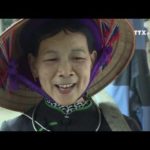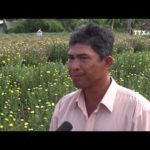To celebrate the Lunar New Year of the Dragon, G39, an artist group, organized the Dragon Exhibition at the Vietnam Museum of Fine Arts in Hanoi on January 24th.
The exhibition showcases over 90 artworks by 20 talented artists. These artworks include paintings and statues made using various materials such as oil paint, gouache, lacquer, do (poonah) paper, acrylic, Huong Canh ceramics, Phu Lang ceramics, and more.
| The exhibition features 90 works by 20 artists. Photo: Ngo Minh/The Hanoi Times |
The highlighted artworks include “Hidden Dragon” by Nguyen Hong Quang, “Playing with Dragons” by Nguyen Quoc Thang, “Giap Thin” by Hoang Phuong Lien, “Tet Flowers” by Binh Nhi, “Fairy Dragon” by Vu Huu Nhung, “Old Tet” by Nguyen Hong Phuong, “Waiting for Spring” by Tao Linh, “Zen Dragon” by Vuong Linh, “Dragon Procession” by Le Thiet Cuong, and “Spring Dragon” by Le Thu Huong.
In addition to the dragon-themed artworks, the exhibition also showcases art pieces with the theme of love for nature and people. Some notable works include “Morning Sun” by Viet Anh, “Listen to the Colors” by Bui Thanh Thuy, “Dance” by Phuong Binh, “Northwest” by Nguyen Thanh Quang, and “Eastern Girl” by Nguyen Minh.
Nguyen Anh Minh, the Director of the Vietnam Museum of Fine Arts, emphasized that the exhibition is a meaningful activity by the G39 group to bid farewell to the old year and welcome the New Year of the Dragon.
The curator, artist Le Thiet Cuong, representing the G39 group, explained that historically, the dragon simultaneously symbolizes kingship in feudal times and plays a significant role in religious symbolism. The dragon is considered one of the four sacred animals: dragon, kylin, turtle, and phoenix.
Among the 12 zodiac animals in Asian tradition, the dragon is the only mythical one that doesn’t exist in reality. However, it is one of the most frequent motifs in Vietnamese art history from the 10th century until the late 19th century.
Throughout the past millennium, the depiction of dragons has evolved, including changes in shape, composition, and materials.
In Vietnamese art history, there are five common motifs of dragons: the dragon of the Ly Dynasty (1009-1225), characterized by smoothness and delicacy with soft curves; the Tran Dynasty (1226-1400) dragon, which looks similar to the Ly Dynasty’s but possesses a different spirit—strong and robust; and the dragon of the Early Le Dynasty (980-1009), which focuses on details and specificity, with less decoration.
Cuong elaborated: “Dragons have been portrayed through various mediums, such as stone, terracotta, wood, ceramics, bronze, and lacquer. They have appeared in different compositions, including rectangular, circular, leaf-shaped, and crescent-shaped.”
By revisiting the dragon in ancient art, today’s artists can continue incorporating this symbol into contemporary artworks, blending tradition with modernity, Cuong concluded.
The exhibition will run until January 30th at the Vietnam Museum of Fine Arts, located at 66 Nguyen Thai Hoc Street, Hanoi.
| Dragon by Le Thiet Cuong. Photo: Ngo Minh/The Hanoi Times |
| A collection of ceramic art by Vu Huu Nhung. Photo: Ngo Minh/The Hanoi Times |
| Le Thiet Cuong’s Carp Turns into Dragon work. Photo: Ngo Minh/The Hanoi Times |
| Sacred Dragon by Vuong Linh. Photo: Ngo Minh/The Hanoi Times |
| Descendants of Dragons and Fairies by Nguyen Quoc Thang. |
| Dragon Dance by Binh Nhi. |
Chrysanthemum season in full bloom in Khanh Hoa
Thanks to favorable weather, chrysanthemum fields in Khanh Hoa province are in full bloom, ready for the Lunar New Year festival. Locals are excited and looking forward to a bumper crop.















